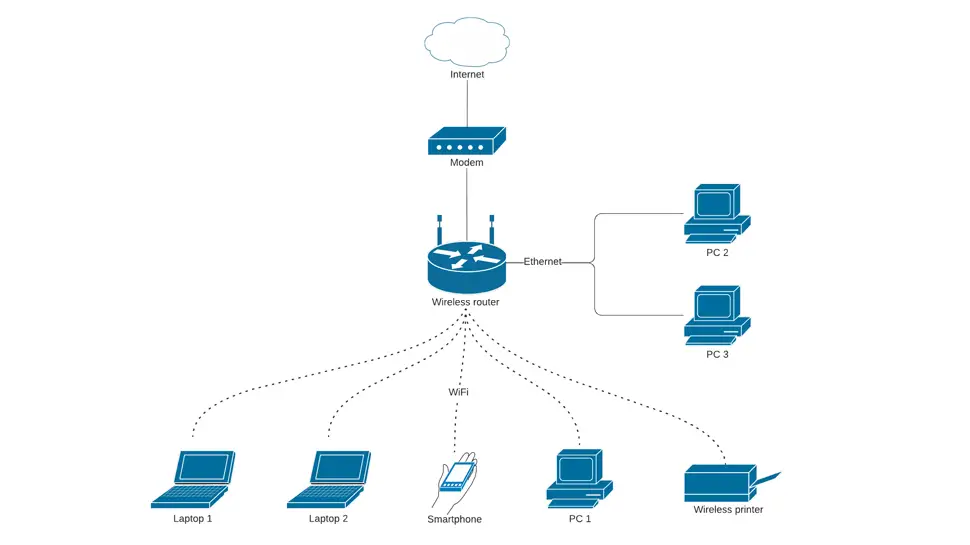Wi-Fi is a technology that enables wireless communication between devices using radio waves. It has become an integral part of our daily lives, allowing us to access information, communicate with others, and work remotely from almost anywhere. In this tutorial, we will cover how Wi-Fi works, the different protocols, security measures, range, and its history.
Contents
- Recommended WiFi Routers
- How Wi-Fi Works
- Different Wi-Fi Protocols
- Wi-Fi Security
- Wi-Fi Range
- Wi-Fi History
- Conclusion
- See Also
- Further Reading
Recommended WiFi Routers
I can highly recommend these WiFi Routers for home or small business.
- Amazon eero mesh WiFi router
- TP-Link AC1200 WiFi Router Archer A54
- TP-Link AX1800 WiFi 6 Router Archer AX21
How Wi-Fi Works
Wi-Fi works by transmitting data between devices using radio waves. A Wi-Fi enabled device, such as a smartphone, laptop, or tablet, sends data to a wireless router using radio waves. The router then transmits the data to the internet or other devices on the same network. The router serves as an intermediary between the device and the internet, allowing multiple devices to connect to the internet simultaneously.
The wireless signal is transmitted using radio waves that operate on different frequency bands. Wi-Fi routers typically operate on either the 2.4GHz or 5GHz frequency band. The 2.4GHz frequency band has a longer range and can penetrate obstacles such as walls, but it is more susceptible to interference from other devices. The 5GHz frequency band, on the other hand, has a shorter range but is less susceptible to interference.

Different Wi-Fi Protocols
There are several Wi-Fi protocols, each with its own specifications and standards. The most common Wi-Fi protocols are:
- 802.11a: This protocol operates on the 5GHz frequency band and can transmit data at speeds of up to 54Mbps.
- 802.11b: This protocol operates on the 2.4GHz frequency band and can transmit data at speeds of up to 11Mbps.
- 802.11g: This protocol operates on the 2.4GHz frequency band and can transmit data at speeds of up to 54Mbps.
- 802.11n: This protocol operates on both the 2.4GHz and 5GHz frequency bands and can transmit data at speeds of up to 600Mbps.
- 802.11ac: This protocol operates on the 5GHz frequency band and can transmit data at speeds of up to 1Gbps.
- 802.11ax: This protocol operates on both the 2.4GHz and 5GHz frequency bands and can transmit data at speeds of up to 9.6Gbps.
The different Wi-Fi protocols offer varying speeds, range, and compatibility with different devices. The newer protocols, such as 802.11ac and 802.11ax, offer faster speeds and more reliable connections, but they require newer devices that support these protocols.
Wi-Fi Security
Wi-Fi security is crucial to protect against unauthorized access and protect your data. There are several security measures that can be implemented to secure Wi-Fi networks. The most common security measures are:
- Wired Equivalent Privacy (WEP): This was the first security protocol for Wi-Fi but has been deprecated and is no longer recommended.
- Wi-Fi Protected Access (WPA): This was introduced as a replacement for WEP and is more secure. It has several versions, with the latest being WPA3.
- WPA2: This is the current industry standard for Wi-Fi security and offers advanced encryption and authentication protocols to protect against hacking and eavesdropping.
Wi-Fi Range
The range of Wi-Fi depends on several factors, including the frequency band, the power output of the router, and any obstacles in the signal path. Typically, Wi-Fi can cover a range of 30-50 meters indoors and up to 100 meters outdoors. However, the range can be extended using Wi-Fi range extenders or mesh networks.
A Wi-Fi range extender is a device that picks up the existing Wi-Fi signal and retransmits it to extend the range. A mesh network, on the other hand, is a system of interconnected devices that work together to extend the Wi-Fi coverage area. In a mesh network, each device serves as a node that communicates with other nodes to create a seamless Wi-Fi network with no dead spots.
Wi-Fi History
Wi-Fi was first introduced in 1997 by the Institute of Electrical and Electronics Engineers IEEE. The first Wi-Fi standard, 802.11, offered data transfer rates of up to 2Mbps. Over the years, Wi-Fi has evolved, with new protocols and standards being introduced to improve speed and security.
In 1999, the IEEE introduced the 802.11b standard, which offered data transfer rates of up to 11Mbps. This was followed by the 802.11a standard in 1999, which operated on the 5GHz frequency band and could transmit data at speeds of up to 54Mbps.
In 2003, the 802.11g standard was introduced, which offered data transfer rates of up to 54Mbps and operated on the 2.4GHz frequency band. In 2009, the 802.11n standard was introduced, which operated on both the 2.4GHz and 5GHz frequency bands and offered data transfer rates of up to 600Mbps.
The 802.11ac standard was introduced in 2013, which operated on the 5GHz frequency band and offered data transfer rates of up to 1Gbps. The latest Wi-Fi standard, 802.11ax, was introduced in 2019, which operates on both the 2.4GHz and 5GHz frequency bands and offers data transfer rates of up to 9.6Gbps.
Conclusion
Wi-Fi is a crucial technology that has revolutionized the way we work and communicate. It uses radio waves to transmit data between devices, and there are several protocols with varying speeds and specifications. Wi-Fi security is essential to protect against unauthorized access, and the range can be extended using range extenders or mesh networks. Wi-Fi has come a long way since its introduction in 1997 and will continue to evolve to meet our ever-changing needs.
See Also
- TCP/IP Protocols: A Short Guide – Learn the Basics
- Connect VPN using L2TP/IPsec on Windows 11
- What is an IP address?
- Computer Network Firewall


Comments
There are currently no comments on this article.
Comment